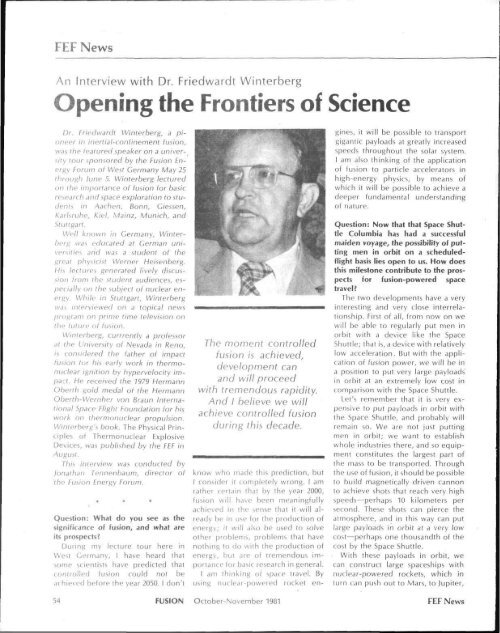Riemann's Contribution to Flight and Laser Fusion
Riemann's Contribution to Flight and Laser Fusion
Riemann's Contribution to Flight and Laser Fusion
- No tags were found...
You also want an ePaper? Increase the reach of your titles
YUMPU automatically turns print PDFs into web optimized ePapers that Google loves.
FEF NewsAn Interview with Dr. Friedwardt WinterbergOpening the Frontiers of ScienceDr. Friedwardt Winterberg, a pioneerin inertial-confinement fusion,was the featured speaker on a university<strong>to</strong>ur sponsored by the <strong>Fusion</strong> EnergyForum of West Germany May 25through June 5. Winterberg lecturedon the importance of fusion for basicresearch <strong>and</strong> space exploration <strong>to</strong> studentsin Aachen, Bonn, Giessen,Karlsruhe, Kiel, Mainz, Munich, <strong>and</strong>Stuttgart.Well known in Germany, Winterbergwas educated at German universities<strong>and</strong> was a student of thegreat physicist Werner Heisenberg.His lectures generated lively discussionfrom the student audiences, especiallyon the subject of nuclear energy.While in Stuttgart, Winterbergwas interviewed on a <strong>to</strong>pical newsprogram on prime time television onthe future of fusion.Winterberg, currrently a professorat the University of Nevada in Reno,is considered the father of impactfusion <strong>to</strong>r his early work in thermonuclearignition by hypervelocity impact.He received the 1979 HermannOberth gold medal of the HermannOberth-Wernher von Braun InternationalSpace <strong>Flight</strong> Foundation for hiswork on thermonuclear propulsion.Winterberg's book. The Physical Principlesof Thermonuclear ExplosiveDevices, was published by the FEF inAugust.This interview was conducted byJonathan Tennenbaum, direc<strong>to</strong>r ofthe <strong>Fusion</strong> Energy Forum.Question: What do you see as thesignificance of fusion, <strong>and</strong> what areits prospects?During my lecture <strong>to</strong>ur here inWest Germany, I have heard thatsome scientists have predicted thatcontrolled fusion could not beachieved before the year 2050. I don'tThe moment controlledfusion is achieved,development can<strong>and</strong> will proceedwith tremendous rapidity.And I believe we willachieve controlled fusionduring this decade.know who made this prediction, butI consider it completely wrong. I amrather certain that by the year 2000,fusion will have been meaningfullyachieved in the sense that it will alreadybe in use for the production ofenergy; it will also be used <strong>to</strong> solveother problems, problems that havenothing <strong>to</strong> do with the production ofenergy, but are of tremendous importancefor basic research in general.I am thinking of space travel. Byusing nuclear-powered rocket engines,it will be possible <strong>to</strong> transportgigantic payloads at greatly increasedspeeds throughout the solar system.I am also thinking of the applicationof fusion <strong>to</strong> particle accelera<strong>to</strong>rs inhigh-energy physics, by means ofwhich it will be possible <strong>to</strong> achieve adeeper fundamental underst<strong>and</strong>ingof nature.Question: Now that that Space ShuttleColumbia has had a successfulmaiden voyage, the possibility of puttingmen in orbit on a scheduledflightbasis lies open <strong>to</strong> us. How doesthis miles<strong>to</strong>ne contribute <strong>to</strong> the prospectsfor fusion-powered spacetravel?The two developments have a veryinteresting <strong>and</strong> very close interrelationship.First of all, from now on wewill be able <strong>to</strong> regularly put men inorbit with a device like the SpaceShuttle; that is, a device with relativelylow acceleration. But with the applicationof fusion power, we will be ina position <strong>to</strong> put very large payloadsin orbit at an extremely low cost incomparison with the Space Shuttle.Let's remember that it is very expensive<strong>to</strong> put payloads in orbit withthe Space Shuttle, <strong>and</strong> probably willremain so. We are not just puttingmen in orbit; we want <strong>to</strong> establishwhole industries there, <strong>and</strong> so equipmentconstitutes the largest part ofthe mass <strong>to</strong> be transported. Throughthe use of fusion, it should be possible<strong>to</strong> build magnetically driven cannon<strong>to</strong> achieve shots that reach very highspeeds—perhaps 10 kilometers persecond. These shots can pierce theatmosphere, <strong>and</strong> in this way can putlarge payloads in orbit at a very lowcost—perhaps one thous<strong>and</strong>th of thecost by the Space Shuttle.With these payloads in orbit, wecan construct large spaceships withnuclear-powered rockets, which inturn can push out <strong>to</strong> Mars, <strong>to</strong> Jupiter,54 FUSION Oc<strong>to</strong>ber-November 1981 FEF News
















